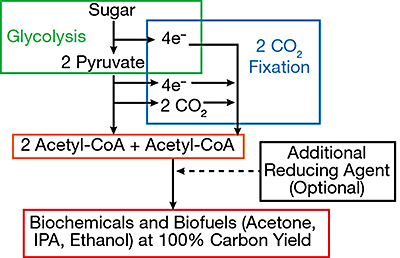The production of bioethanol fuel by fermentation generates a significant amount of CO2 as a byproduct; every ton of ethanol produced is accompanied by a ton of CO2, which not only impacts the environment but also process yields and therefore costs. With 50 billion gal/yr of ethanol fuel produced in the U.S., this adds up to 45 million m.t. CO2 released annually.
With funding from the National Science Foundation (NSF), New Castle, DE-based Elcriton, Inc. has developed a way to ferment sugar into ethanol while simultaneously converting CO2 into an intermediate that can be further processed into ethanol or other bio-products.

▲ Elcriton’s proprietary microbes convert sugar carbon to acetyl-CoA through the combination of glycolysis, pyruvate decarboxylation, and carbon fixation via the reductive acetyl-CoA pathway. The microbes fix all released CO2, which maximizes the conversion of carbon to target products.
The key to the development is bacteria known as acetogens, which both ferment sugars and fix CO2 to stoichiometrically produce acetyl-CoA, an important catalyst in biochemical reactions and a central building block in metabolism. The bacteria can then convert acetyl-CoA into a diversity of biochemicals. Acetogens consume sugar through standard glycolysis, and fix CO2 through the reductive acetyl-CoA pathway (also known as the Wood-Ljungdahl pathway).
The microbe performs these reactions through two separate pathways that operate simultaneously. Little has been done, however, to optimize them for concurrent sugar fermentation and CO2 fixation, partly because acetogens are difficult to genetically engineer and recombinant DNA technology to do so was not available until recently.
Elcriton has developed a process to ferment sugar into several useful chemicals, including ethanol, as well as acetone, isopropanol (IPA), and butyric acid, by way of acetyl-CoA without releasing any CO2.
The process involves genetically modified acetogen bacteria that have had some genes knocked out and additional genes introduced. The modified acetogens metabolize sugar, producing pyruvate, which undergoes decarboxylation to form acetyl-CoA, producing CO2 in the process. The microbes then turn the acetyl-CoA into ethanol (or other product), producing more CO2. Simultaneously, the bacteria activate the gas-consumption pathway and consume the CO2 evolved during sugar fermentation, forming more acetyl-CoA, which is converted into more ethanol.
The technology also involves the addition of hydrogen or synthesis gas (a mixture of CO, CO2, and H2) to the fermentation broth. Because the chemicals produced contain more energy (on a carbon basis) than the sugar being consumed, the only way to convert all of the carbon in sugar into product without generating extra CO2 is to add energy to the system. This is done by adding hydrogen or synthesis gas. “If you make the syngas with the correct mixture of CO, CO2, and hydrogen, it has the right energy content such that all of the carbon you introduced into the fermentation system can be converted into your desired products,” says Bryan Tracy, CEO and founder of Elcriton.
The process operates continuously, which increases volumetric productivity by two orders of magnitude, and proportionally reduces fermentation volumes and capital costs by 50% or more compared to the typical batch processes used in fermentation.
“Sugar fermentation provides excess biological energy (i.e., adenosine triphosphate [ATP]) through glycolysis, but suffers from CO2 loss. Gas fermentation has challenges in generating ATP, but fixes CO2 and other gases. Thus, our novel mixotrophic approach combines the advantages of both technologies to mitigate the disadvantages,” Tracy says.
In response to market demand, the company is focused on scaling up a continuous fermentation process to produce 100 kg/day of acetone, with the goal of supporting engineering design for scaleup to a commercial production plant.
Overall, this technology platform can maximize the value of a highly optimized sugar industry, while integrating with new carbon and chemically reducing sources such as bio- and waste-based gases. Since acetyl-CoA — the biochemical building block for many chemicals — is the focal point of the technology, the potential chemical and fuel markets are huge.
Chemical companies are evaluating this mixotrophic platform, which has the potential to address many of the requirements for an industrial process, says Wilfried Blümke, director of Bioprocess Technology & Life Cycle Management, Evonik.
This technology was funded through the NSF Small Business Innovation Research Program.
This article was prepared by the National Science Foundation in partnership with CEP.

Copyright Permissions
Would you like to reuse content from CEP Magazine? It’s easy to request permission to reuse content. Simply click here to connect instantly to licensing services, where you can choose from a list of options regarding how you would like to reuse the desired content and complete the transaction.
